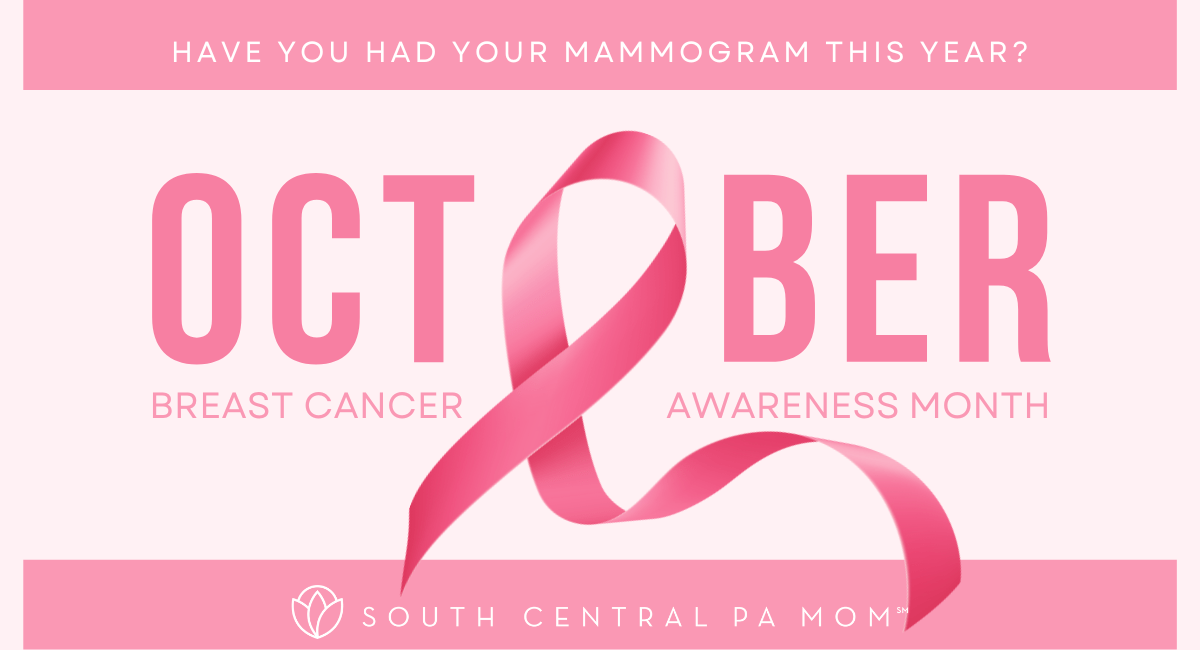
Today is National Mammography Day! Celebrated the third Friday of every October, during Breast Cancer Awareness Month, National Mammography Day serves as a reminder of how important mammograms are – and to schedule one if you haven’t yet.
This is an issue of personal importance to me; I have a gene which puts me at higher risk for ovarian and breast cancers. It’s called RAD51D – there are many more cancer genes than just BRCA! — and so, at a relatively young age, I had my fallopian tubes removed to lessen the risk of ovarian cancer, and began getting yearly mammograms.
If you’re not familiar with why getting a timely mammogram is so important, it’s because they’re literally life-saving. If diagnosed early, breast cancer is highly survivable, and mammograms have cut the risk of dying from breast cancer nearly in half, as well as cut breast cancer mortality by almost 40%.
Maybe you’re still young, and think a mammogram isn’t something you need to worry about yet. But it’s never too early to take breast health seriously, and we’re going to walk you through everything you need to know.
Step 1: Self-Exams
Every woman should be performing self-exams at least once a month. Ideally, you should do it at the same time each month, as your breasts can feel differently depending on where you are in your menstrual cycle. Before your period, for example, you might have some lumps pop up, or your breasts might be sore. The best time to conduct a self-exam is generally believed to be a few days after your period ends.
So how do you do it? You’ll want to examine your breasts in the shower, in front of a mirror, and lying down. Using three fingers, palpate the entire breast, including near your armpit. You’ll want to be checking for any new lumps, thickenings, knots, or other changes. In the mirror, there can be visual changes as well — such as the contour or shape of your breasts, dimpling, swelling, or any other irregularities.
If you see or feel anything different, don’t panic; it just means it’s time to put a call in to your doctor to get it formally checked out. Most lumps will not be breast cancer, but it’s always better to be safe than sorry.
Step 2: Scheduling a Mammogram
Typically, doctors will begin scheduling women for mammograms at the age of 40, or younger, if you’re in a situation like mine. If there aren’t any issues, you’ll just have a screening mammogram; however, if any irregularities are found during a self-exam or a doctor’s exam, you may be referred for a diagnostic mammogram.
A diagnostic mammogram is very similar to a screening mammogram, but from your perspective, will simply take longer. More x-rays will be taken, and it’s more likely to spot small tumors or ductal carcinoma in situ.
Looking for where to get your mammogram? The National Breast Cancer Foundation has a great tool allowing you to search facilities here. Most mammograms are covered by insurance, but if you don’t have health insurance, there are free mammograms available through the National Breast Cancer Foundation’s National Mammography Program.
Step 3: What are Mammograms Like?
As I’m the lucky recipient of a super-fun cancer gene, I’ve been through numerous mammograms, all before the age of 40. And lucky you, I’m here to share my knowledge!
One of the first things to know is that, on the day of your mammogram, `you should not wear any deodorant, lotion, perfume, or oil; they can interfere with the machine. You’ll check in, and typically, be taken to a waiting room with other women. There will be a locker for you to place your things, as you’ll undress from the waist up, and have a robe to wear while you wait.
When it’s time for your mammogram, you’ll be taken into the exam room; it will only be you and the technician. The breast tissue needs to be spread out during the screening, so it’s a little uncomfortable, but not painful. The technologist will be the one manipulating the tissue to get it in the right position, so yes, she will be touching your breasts. If you have any moles or spots, little stickers will be placed there so they’re marked in the images as being normal.
In a typical screening mammogram, your breast will first be compressed flat from above, and then, the machine will be rotated so they’re compressed side-to-side. Then they’ll switch and do the other breast. Again, while it’s not a fun experience, it shouldn’t be painful or terribly uncomfortable; if it does hurt, let your technician know so she can adjust the machine.
Altogether, the actual mammogram process should only take about 10 minutes. A diagnostic mammogram takes a little bit longer, but the overall process is mostly the same, except more images will be taken.
Step 4: After the Mammogram
The images will be examined by a radiologist and your doctor. They’ll be looking for things like breast density, calcifications, or any masses in your breasts. Though you should get the results sooner, your mammography center is required to give you a summary of their findings within 30 days. Most of the time, everything will be fine and you’ll just wait for the next year to come around and do it all over again.
But what if there are abnormal results? Depending on what they find, the doctor has a number of things they may opt for. If the results were found from a screening mammogram, they may send you for a diagnostic mammogram. Another option is a breast MRI. During a breast MRI, a contrast dye will be injected into your veins through an IV, and then you will lay down on your stomach with your arms above your head. The table you’re lying on then goes inside an MRI machine, which basically looks like a long metal tube. You may hear noises, like clicking or whirring, or be asked to hold your breath. It should take less than an hour.
If breast cancer is suspected, whether from a mammogram or an MRI, it will be diagnosed by performing a biopsy. There are various biopsy methods, which may use needles or may be surgical. The cells will be examined by a pathologist, who can determine for sure if any cancer is present. If it is, your doctor will explain to you about what kind of breast cancer you have, as well as what your treatment options are.
And there you have it: a complete guide to mammograms to walk you through the process. Have you scheduled yours yet?




